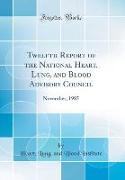- Start
- Twelfth Report of the National Heart, Lung, and Blood Advisory Council
Twelfth Report of the National Heart, Lung, and Blood Advisory Council
Angebote / Angebote:
Excerpt from Twelfth Report of the National Heart, Lung, and Blood Advisory Council: November, 1985The death rate from cardiovascular disease in the United States has been steadily declining. From 1968 to 1978 the age-adjusted death rate (a calculated figure enabling comparisons free of the effects of age differences and other vari ables) declined 25 percent for coronary heart disease, 37 percent for stroke, 53 percent for hypertensive disease, and 38 percent for rheumatic heart disease. For the most part, these statistics describe the trends for adults with heart and vascular diseases. Another group of patients, with a different set of heart problems, consists of children with congenital heart disease. The problems in these children begin early in the prenatal period with abnor mal development of the heart, which may result in underdeveloped or malformed heart chambers or in openings (that should have closed) between chambers. Although the number of us. Children under 17 who have cardiovascular diseases of various kinds is small in comparison to the number of adults with such diseases (about million children vs. About 47 million adults), the problems of these children should not be forgotten in the total picture of cardiovascular diseases in the United States. During the past decade, marked progress has been made in the diagnosis, treatment, and prevention of cardiovascular diseases in infants and children. This section will highlight some of the advances that have helped increase the survival of children with heart disease.In the 1950's the prognosis was virtually hopeless for many children with congenital heart disease. Almost all children with cyanotic heart disease (heart disorders in which the blood is provided with too little oxy gen) died soon after birth, and many children with acyanotic heart disease (heart disorders in which the blood carries enough oxygen but other problems exist) died later in childhood. Correct diagnosis of congenital heart lesions was just becoming feasible with the advent of cardiac catheterization (passage of a small flexible tube, or catheter, through a blood vessel into the heart), which was available only to older children and adults. Surgery was primitive by today's standards and was limited to procedures on the blood vessels outside the heart.About the PublisherForgotten Books publishes hundreds of thousands of rare and classic books. Find more at www.forgottenbooks.comThis book is a reproduction of an important historical work. Forgotten Books uses state-of-the-art technology to digitally reconstruct the work, preserving the original format whilst repairing imperfections present in the aged copy. In rare cases, an imperfection in the original, such as a blemish or missing page, may be replicated in our edition. We do, however, repair the vast majority of imperfections successfully, any imperfections that remain are intentionally left to preserve the state of such historical works.
Folgt in ca. 10 Arbeitstagen
